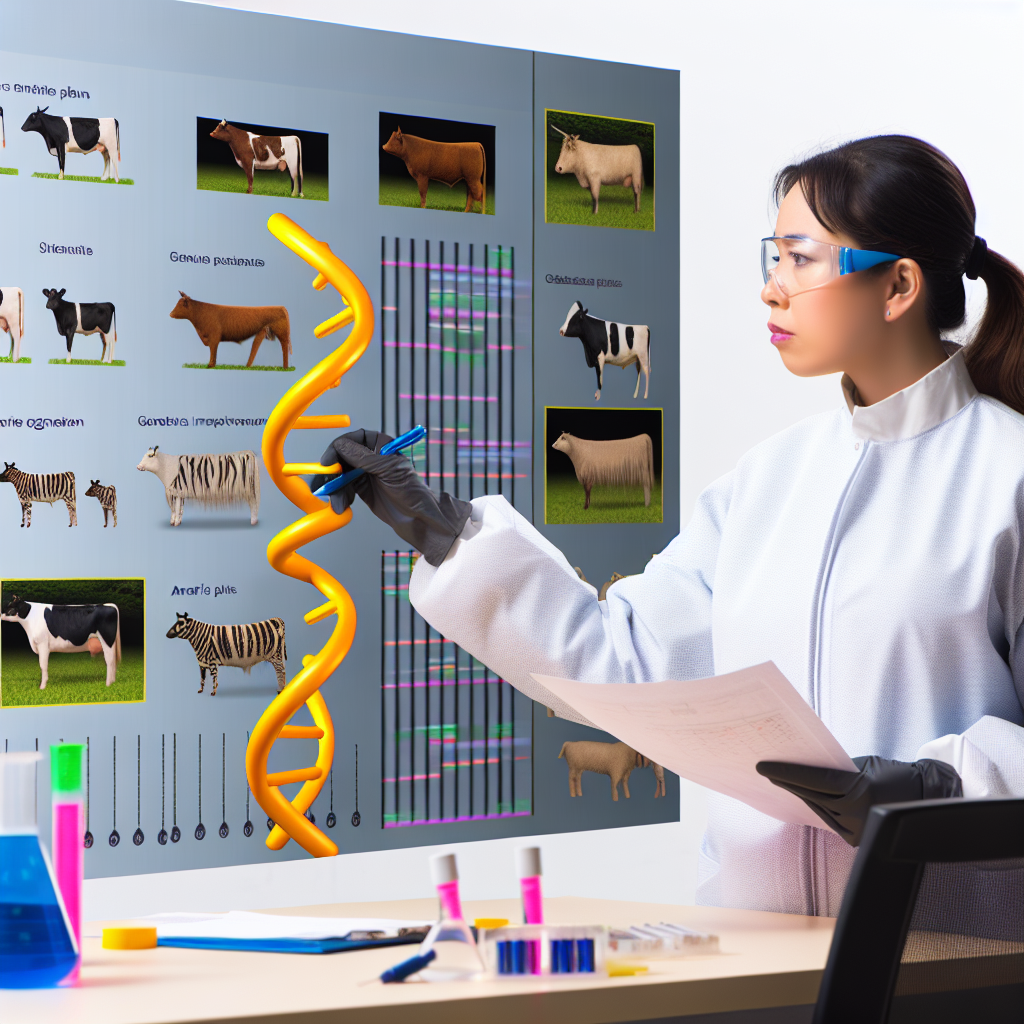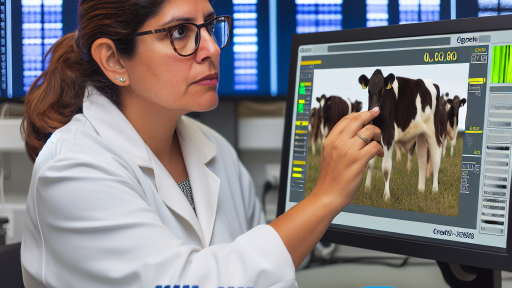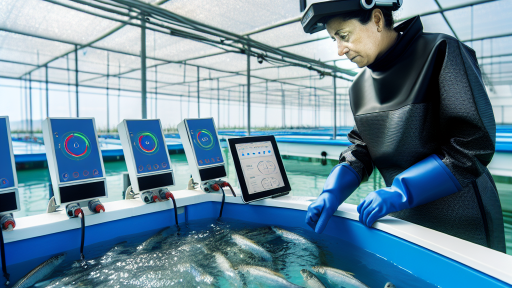Introduction to Genetic Improvement in Livestock
Genetic improvement plays a vital role in livestock production.
This process enhances traits such as growth rate and disease resistance.
Farmers and breeders utilize various techniques for this purpose.
As a result, livestock performance improves significantly.
Understanding Genetic Selection
Genetic selection focuses on propagating desirable traits.
Breeders choose animals that exhibit strong genetic characteristics.
Moreover, they consider both phenotypic and genotypic traits.
Using data helps identify the best candidates for breeding.
Technological Advances in Genetic Improvement
Recent technological developments have transformed genetic improvement.
Genomic selection is one of the most important innovations.
This method uses DNA information to predict an animal’s performance.
Moreover, gene editing techniques offer precise enhancements.
These technologies streamline the breeding process and increase accuracy.
Breeding Goals and Objectives
Establishing clear breeding goals enhances the genetic improvement process.
Goals may include improving milk production or meat quality.
Transform Your Agribusiness
Unlock your farm's potential with expert advice tailored to your needs. Get actionable steps that drive real results.
Get StartedAdditionally, breeding objectives often focus on enhancing fertility rates.
Involving stakeholders ensures the goals align with market demands.
Implementation of Genetic Improvement Plans
Creating effective genetic improvement plans requires careful planning.
First, farmers must gather relevant data about their livestock.
Next, they can select appropriate breeding strategies based on this data.
Continuous evaluation allows for adjustments to the improvement plan.
This adaptability helps ensure long-term success in livestock breeding.
The Role of Education and Training
Education plays a crucial role in successful genetic improvement.
Workshops and training programs enhance understanding of breeding techniques.
Furthermore, these programs help farmers stay updated on innovations.
Ultimately, knowledge empowers breeders to make informed decisions.
Understanding the Importance of Genetic Variation
Foundations of Genetic Variation
Genetic variation is essential for healthy livestock populations.
This variation enhances adaptability to changing environments.
Furthermore, it helps improve overall productivity.
Benefits of Genetic Diversity
Genetic diversity minimizes the risks of disease outbreaks.
It ensures that some animals may survive adverse conditions.
Additionally, diverse genetics lead to better growth rates.
Moreover, it can improve reproductive performance in animals.
Strategies for Enhancing Genetic Variation
Utilizing crossbreeding techniques can effectively increase diversity.
Incorporating genetic testing allows for informed breeding decisions.
Moreover, collaborating with geneticists can enhance improvement plans.
Implementing artificial insemination opens up wider genetic pools.
Monitoring Genetic Progress
Regular evaluations of genetic performance are crucial.
Utilizing performance data helps track improvements.
Showcase Your Farming Business
Publish your professional farming services profile on our blog for a one-time fee of $200 and reach a dedicated audience of farmers and agribusiness owners.
Publish Your ProfileFurthermore, identifying superior genetics can guide future decisions.
Behavioral assessments can also provide valuable insights.
Key Strategies for Livestock Selection and Breeding
Understanding Genetic Selection
Genetic selection plays a crucial role in livestock improvement.
This process involves choosing animals with desirable traits for breeding.
It enhances the overall quality of the livestock population.
Furthermore, it focuses on specific goals such as growth rate and disease resistance.
Evaluating Breeding Values
Breeding values help producers make informed decisions.
These values predict an animal’s potential contribution to the next generation.
Producers must assess traits like fertility, weight gain, and milk production.
Consequently, understanding these values can improve breeding outcomes.
Implementing Crossbreeding Techniques
Crossbreeding introduces genetic diversity into herds.
It can enhance traits that may be lacking in purebred lines.
This technique often results in hybrid vigor, leading to healthier animals.
Moreover, crossbreeding allows for flexibility in meeting market demands.
Utilizing Technology in Breeding Programs
Technology significantly enhances livestock breeding efforts.
Genomic selection offers insights into the genetic makeup of animals.
Additionally, data management tools streamline record-keeping and analysis.
This integration leads to more accurate selection decisions.
Establishing Performance Records
Maintaining accurate performance records is essential for successful breeding.
Records provide valuable information on growth rates and health metrics.
Producers can analyze this data to track genetic progress over time.
Ultimately, effective record-keeping supports informed decision-making.
Engaging in Cooperative Breeding Programs
Cooperative breeding programs foster collaboration among producers.
Such programs leverage shared knowledge and resources for better outcomes.
They often increase the genetic pool available for selection.
In addition, these initiatives can reduce costs associated with individual breeding efforts.
Educating Producers on Best Practices
Education plays a pivotal role in successful livestock improvement.
Producers should stay updated on the latest breeding techniques.
Workshops and seminars provide valuable hands-on learning opportunities.
Furthermore, sharing experiences among peers can drive better practices.
Learn More: Economic Benefits of Investing in Fish Farming
Methods of Genetic Evaluation
Performance Evaluation
Performance evaluation examines the actual production traits of livestock.
This method analyzes various metrics such as growth rates, milk production, and feed efficiency.
By collecting data over time, breeders can identify superior individuals.
Additionally, performance evaluation relies on comparing animals within the same environment.
For instance, two bulls might be compared based on their weight gain under similar feeding conditions.
Such evaluations help breeders make informed decisions for genetic improvement.
Pedigree Analysis
Pedigree analysis involves studying ancestral lineage to assess genetic potential.
It provides insights into hereditary traits passed from parent to offspring.
In many cases, valuable information lies in the historical performance of the lineage.
Showcase Your Farming Business
Publish your professional farming services profile on our blog for a one-time fee of $200 and reach a dedicated audience of farmers and agribusiness owners.
Publish Your ProfileBreeders utilize pedigree records to make selections that enhance desired traits.
For example, if a bull’s father had a high milk yield, the offspring may also have that potential.
Understanding the pedigree can help mitigate genetic diseases prevalent in certain lines.
Genomic Selection
Genomic selection incorporates advanced DNA technology into breeding strategies.
This method analyzes genetic markers associated with desirable traits.
As a result, breeders can predict the performance of animals more accurately.
Implementing genomic data reduces the time needed to achieve genetic improvement.
Moreover, it allows for more efficient selection, increasing the overall quality of livestock.
For example, genomic tools can quickly identify genetic predispositions to diseases.
Comparative Analysis of Methods
Each method of genetic evaluation has its strengths and weaknesses.
Performance evaluation is straightforward and easy to implement.
However, it may not always account for genetic potential influenced by ancestry.
Conversely, pedigree and genomic analyses provide deeper insights but require more resources.
Ultimately, combining methods can yield the best results in livestock improvement.
This holistic approach leverages the strengths of each technique effectively.
Delve into the Subject: Creating a Successful Breeding Program from Scratch
Developing Breeding Objectives
Defining Economic Goals
Economic goals are essential in livestock breeding programs.
Farmers must focus on profitability to sustain their operations.
Moreover, understanding market demands helps in setting clear objectives.
Producers should prioritize traits that enhance meat quality and yield.
Breeding for improved feed efficiency can significantly reduce costs.
Additionally, target reproductive performance to optimize herd productivity.
Environmental Sustainability
Integrating environmental considerations is crucial in breeding plans.
Sustainable practices can lead to healthier ecosystems.
Breeding livestock for lower emissions helps combat climate change.
Additionally, selecting for hardiness can reduce reliance on veterinary interventions.
Moreover, efficient resource use minimizes waste and conserves water.
Balancing Economic and Environmental Objectives
A successful breeding program harmonizes economic and environmental goals.
Farmers need to assess trade-offs when selecting breeding objectives.
For instance, higher milk production may increase environmental impacts.
Conversely, breeding for resilience can enhance long-term profitability.
Collaboration with experts can provide valuable guidance in this area.
Engaging Stakeholders
Effective breeding plans require input from various stakeholders.
Producers should engage agricultural advisors and scientists.
Furthermore, consumer preferences must also drive breeding objectives.
Implementing feedback mechanisms can lead to continuous improvement.
Regular updates and assessments ensure alignment with market trends.
Explore Further: Effective Feed Management Strategies for Aquaculture
Implementing Data Management Systems for Genetic Tracking
Importance of Data Management
Data management is crucial for effective genetic tracking in livestock.
It allows breeders to monitor traits and lineage accurately.
Showcase Your Farming Business
Publish your professional farming services profile on our blog for a one-time fee of $200 and reach a dedicated audience of farmers and agribusiness owners.
Publish Your ProfileMoreover, proper management facilitates informed breeding decisions.
Consequently, genetic diversity can be preserved more effectively.
Choosing Appropriate Software
Selecting the right software is essential for successful data management.
Many options are available, each with distinct features.
Consider user-friendliness and compatibility with existing systems.
Additional features like cloud storage can enhance data accessibility.
Data Collection Techniques
Effective data collection supports accurate genetic tracking.
Utilize both traditional methods and modern technologies.
Genetic testing provides precise lineage information.
Furthermore, electronic identification systems streamline data entry.
Data Security Measures
Securing data is a priority in genetic management systems.
Adopt encryption techniques to protect sensitive information.
Regular backups ensure data is recoverable in case of emergencies.
Additionally, access controls limit who can view or edit data.
Integrating Data into Breeding Plans
Integration of data into breeding plans maximizes genetic improvement.
Utilize collected data to identify desirable traits effectively.
Track performance metrics over time to refine selection processes.
This strategy ultimately enhances herd quality and productivity.
Training and Support for Users
Training users on data management systems fosters efficiency.
Provide workshops and online resources to assist users.
Ongoing support ensures challenges can be addressed promptly.
This commitment to user education leads to better data outcomes.
See Related Content: Benefits of Artificial Insemination in Livestock

Monitoring and Evaluating Progress of Genetic Improvement Plans
Establishing Baseline Measurements
Establishing baseline measurements is essential in genetic improvement planning.
These metrics provide a point of reference for future evaluations.
Gather initial data on key traits of interest for the livestock.
Examples include growth rates, reproductive performance, and disease resistance.
Use genomic data alongside phenotypic measurements for a comprehensive view.
Setting Clear Objectives
Clear objectives guide the implementation of genetic improvement plans.
Identify specific traits you want to enhance in your livestock population.
Set realistic timelines for achieving these objectives.
This approach ensures that everyone involved is aligned in their efforts.
Implementing Data Collection Strategies
Developing effective data collection strategies is critical for monitoring progress.
Utilize technology such as software programs for tracking genetic data.
Regularly collect data on performance indicators to assess improvement.
Establish protocols for consistent and accurate recording of information.
Analyzing Genetic Progress
Regular analysis of genetic progress is necessary to evaluate effectiveness.
Use statistical methods to analyze collected data over time.
Monitor changes in target traits to determine if objectives are met.
Investigate correlations between genetic selection and observed performance.
Showcase Your Farming Business
Publish your professional farming services profile on our blog for a one-time fee of $200 and reach a dedicated audience of farmers and agribusiness owners.
Publish Your ProfileAdjusting Improvement Plans
Adapt improvement plans based on the findings from your analyses.
Stay flexible to make necessary adjustments to strategies as needed.
Engage stakeholders in discussions about any changes in goals or tactics.
These adjustments ensure ongoing success in genetic improvement efforts.
Utilizing Industry Benchmarks
Benchmarking against industry standards enhances evaluation efforts.
Compare your livestock’s performance with similar operations in the field.
Use this data to identify areas for further improvement.
Staying informed about industry trends will also guide your strategies.
Challenges and Solutions in Genetic Improvement Programs
Understanding Genetic Variation
Genetic variation is crucial for livestock improvement.
However, some breeds exhibit limited genetic diversity.
This restriction may reduce the effectiveness of genetic improvement.
To overcome this challenge, breeders should introduce new genetic material.
Collaboration with research institutions can enhance diversification.
Managing Inbreeding Risks
Inbreeding poses significant risks in livestock breeding programs.
It can lead to decreased fertility and increased disease susceptibility.
Breeders must monitor genetic lines carefully to prevent this issue.
Utilizing genomic selection methods may help identify optimal breeding pairs.
Furthermore, implementing rotating breeding systems can mitigate inbreeding.
Data Collection and Analysis
Accurate data collection is essential for effective genetic improvement.
Yet, many programs struggle with incomplete or inaccurate data.
Implementing robust data management systems can address this problem.
Additionally, leveraging technologies like RFID can streamline data collection.
Data analytics tools enable breeders to make informed decisions faster.
Market Demands and Consumer Preferences
Shifts in market demands influence breeding strategies significantly.
Consumers increasingly prefer animals raised sustainably.
Breeding programs must adapt to these changing preferences.
Incorporating traits like disease resistance can benefit both producers and consumers.
Additionally, educating stakeholders about these traits is critical.
Financial Constraints and Funding Opportunities
Many genetic improvement programs face financial challenges.
Lack of funding can limit the scope of research and development.
Identifying grants and subsidies can provide necessary financial support.
Collaborating with agricultural organizations can open additional funding sources.
Investing in strategic partnerships enhances financial stability over time.
Regulatory and Ethical Considerations
Navigating regulatory frameworks presents challenges for breeders.
Ethical considerations around genetic modification must be addressed proactively.
Engaging with regulators early in the improvement process helps ensure compliance.
Transparency in breeding practices fosters public trust and support.
Furthermore, adhering to ethical standards promotes industry integrity.
Future Trends in Livestock Genetic Improvement
Advancements in Genetic Technology
New genetic technologies are revolutionizing livestock improvement.
Genomic selection enhances breeding efficiency significantly.
Showcase Your Farming Business
Publish your professional farming services profile on our blog for a one-time fee of $200 and reach a dedicated audience of farmers and agribusiness owners.
Publish Your ProfileThis method accelerates the selection process compared to traditional practices.
Moreover, it offers tools for predictive modeling.
For instance, CRISPR technology allows precise editing of the genome.
This technology can eliminate genetic diseases in livestock populations.
Big Data and Analytics
Big data is transforming livestock management significantly.
Farmers can collect vast amounts of data through sensors and tracking devices.
This data provides insights into animal health and productivity.
Furthermore, advanced analytics help in making informed breeding decisions.
For example, predictive analytics allows breeders to forecast traits effectively.
This approach enhances the overall genetic progress in herds.
Collaboration and Data Sharing
Collaboration between breeders and researchers is crucial for success.
Joint efforts can facilitate the sharing of genetic information.
Additionally, centralized databases help in tracking genetic traits.
This fosters a more informed and transparent breeding process.
As a result, it enhances the speed and accuracy of genetic improvement plans.
Sustainable Practices in Livestock Breeding
There is a growing focus on sustainability in livestock breeding.
This trend aligns with consumer demands for ethical practices.
Breeders are now prioritizing traits that enhance environmental resilience.
For instance, selecting for lower methane emissions is becoming common.
Furthermore, sustainable breeding practices support animal welfare.
This ensures that livestock rearing is both efficient and responsible.
Integration of Artificial Intelligence
Artificial intelligence (AI) is becoming a vital tool in livestock management.
AI algorithms analyze breeding data to identify optimal pairings.
Thus, they significantly improve herd performance and genetic diversity.
Additionally, AI can assist in monitoring animal health in real time.
This allows farmers to make timely interventions when necessary.
Ultimately, these technologies enhance the overall livestock industry.




